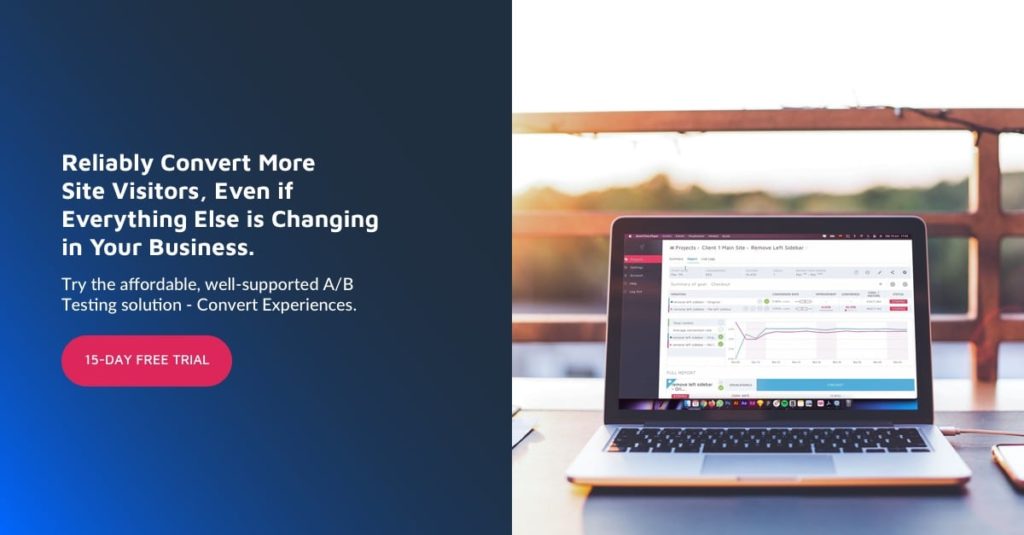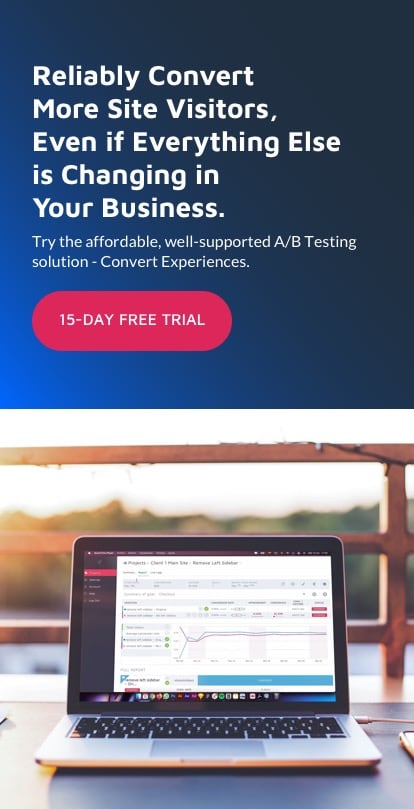When HBR requested for one-word responses to how
their complex-solutions buy processes felt like, 1000’s of B2B patrons stated that it was: “laborious,” “terrible,” “painful,” “irritating,” and “minefield.”
In one other survey of B2B clients, Gartner
discovered 77% of the respondents stating that “their newest buy was very advanced or
troublesome.“
Why would the shopping for course of with a B2B
firm like yours — that is aware of who it’s serving (segments and all) and their
wants and motivations — really feel so horrible? That is so, to an extent, as a result of
your B2B patrons are consumerizing. And their
expectations when “buying” with you now piggyback on their shopping for
experiences with typical on-line shops. They count on you to anticipate their
wants and motivations higher and serve solely what they’d discover useful.
Stated one other manner:
Your corporation clients need customized shopping for experiences like those they get as a client, even after they’ve their B2B patrons hats on.
Why? As a result of personalizations act as a
private concierge that relieves them of the shopping for overwhelm, attributable to too
many selections and an excessive amount of info. These, as HBR explains, end result within the B2B
decision-makers getting pushed “into
unproductive, open-ended studying loops by the deluge of data.
To capitalize on the rising B2B purchaser
consumerization pattern that requires personalization, the primary channel you
ought to optimize is your WEBSITE. As a result of not solely is it your “simplest demand era tactic for
constructing consciousness and growing consideration” (as Forrester discovered) nevertheless it’s usually your lead’s
first touchpoint.
So let’s have a look at 3 ways in which you’ll be able to
make your web site extra related to every lead that lands on it.
However first, let’s see what personalization-at-scale isn’t…
Personalization-at-scale ≠ rampant private knowledge profiling
The largest impediment in implementing
personalization or personalization-at-scale is acquiring, integrating, and
defending person knowledge.
This represents a three-fold problem:
- The primary half is (re)gaining the
fast-eroding belief of digital customers.
- The second comes from bringing all
the info collectively from totally different sources, channels, and platforms.
- And the third springs from the
stringent regulatory insurance policies redrawing the disputed digital privateness traces.
Now, knowledge IS the gasoline that runs
personalization engines.
However most types of personalizations aren’t data-guzzling in any respect. Main optimizer and personalization professional, Ruben Teunissen, explains this in his 3-tier personalization pyramid:
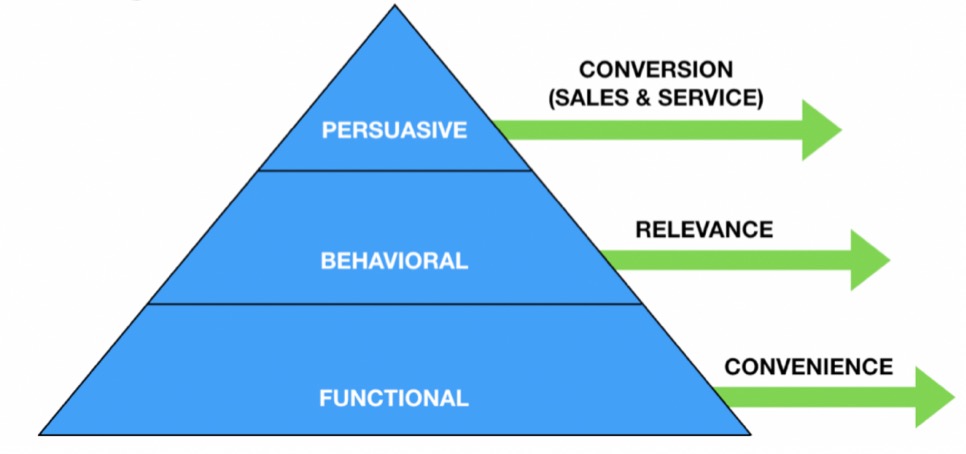

Teunissen categorically factors out that you just
can implement lots of personalization even with no private person knowledge,
particularly these which might be aimed toward providing handy and related web site
experiences.
Localizing a web site for a Dutch or German
native, for example, may be very related personalization, however unbiased of
private knowledge.
Likewise, in case your net analytics instrument predicts
that an anonymized customer will more than likely abandon your web site (utilizing
predictive analytics), exhibiting them a customized provide additionally doesn’t want any
private knowledge.
In distinction with these, although, is exhibiting a
hyper-targeted signup provide to a lead you may “acknowledge” out of your
CRM.
So, no, you don’t must convert your
enterprise into a knowledge surveillance company to supply customized experiences; you
can serve lots of them with no private knowledge in any respect.
Let’s now see just a few privacy-friendly
personalization-at-scale techniques and in addition those that want private knowledge.
Right here goes.
Personalization-at-scale: One-to-Many
The one-to-many personalization-at-scale sort
helps you to personalize your web site expertise for tens of millions of your customers at
as soon as.
Right here, you want to:
- Determine the big cohorts that exist in your goal audiences.
- Do a broad evaluation of their intents.
- And personalize the high-impact components in your web site — similar to your homepage’s headline or worth proposition or the pricing info — based mostly in your findings.
In a single stride, this personalization makes
you look extra related to most of your customers.
Let’s take an instance.
Suppose you’re a compliance resolution supplier
and your cookie/consent administration resolution helps your clients keep compliant
with the legal guidelines they fall celebration to. For the sake of this instance, let’s say you
serve solely US-based companies.
Now, on this case, your audience’s
places develop into probably the most related and apparent grouping you can use, as a result of
all of the states you serve might need new rules passing on a regular basis, and
lots of them may solely apply state-wide.
When you’ve recognized such broad streaks in
your knowledge, you want to transfer to intent evaluation. Right here you wish to be taught what
drives the totally different results in your resolution and the way they differentiate (on a
broad foundation) from one another.
So that you may wish to discover out if…
… Californians fear extra about privateness or
getting fined?
… How their wants along with your resolution differ
from these of Pennsylvanians?
And so forth.
And how will you discover this info?
You could possibly discover a few of these insights by
analyzing your present clients from the totally different states, the overall search
tendencies, and in addition by sourcing non-personal knowledge from third-party knowledge exchanges
as it may possibly shine gentle on their behaviors and pursuits.
Ideally, you’d do that for the highest few cities
that generate most of your income.
Then utilizing your learnings, you’d, for instance, write customized headlines dropping names of the consent legal guidelines which might be producing probably the most buzz in these areas. You could possibly additionally use a messaging type that matches that of your leads from every.
Measuring the affect of such personalizations the place you’ve a good pattern measurement is fairly simple. Teunissen suggests making a management and an experiment group. After which evaluating the conversions of the experiment group (that was uncovered to personalizations) with the management group (that noticed the overall web site or pages) when it’s the correct time.
Personalization-at-scale: One-to-Few
In distinction to the
one-to-many personalization-at-scale sort — the place you have a look at your common
demographics and broad degree intent alerts —
the one-to-few personalization-at-scale tactic forces you to determine
the totally different viewers segments that exist in your demographics.
Right here, you want to:
- Determine your (highest-value) segments.
- Map the “key touches” of their shopping for journey.
- Personalize these key touches with customized messaging, content material, and communications.
Let’s carry ahead the identical instance from
above…
So let’s say that you just analyzed your current
buyer base and located SaaS corporations from the fintech, healthtech, and adtech
verticals to be your highest paying customers, additionally making the bulk; adopted
by just a few non-significant ones.
Now, these are very particular segments and
whereas every will comply with the identical shopping for journey, the motivations, wants, and
wishes of every fluctuate vastly.
You may in all probability even be having a touchdown
web page concentrating on every.
However right here’s the factor:
Personalizations go manner past customized touchdown pages, as a result of they’re are sometimes multi-page and pan throughout all the shopping for journey, of which a custom-made touchdown web page is only one half. Within the following graphic, McKinsey plots the multi-touch shopping for journey of a typical B2B purchaser:
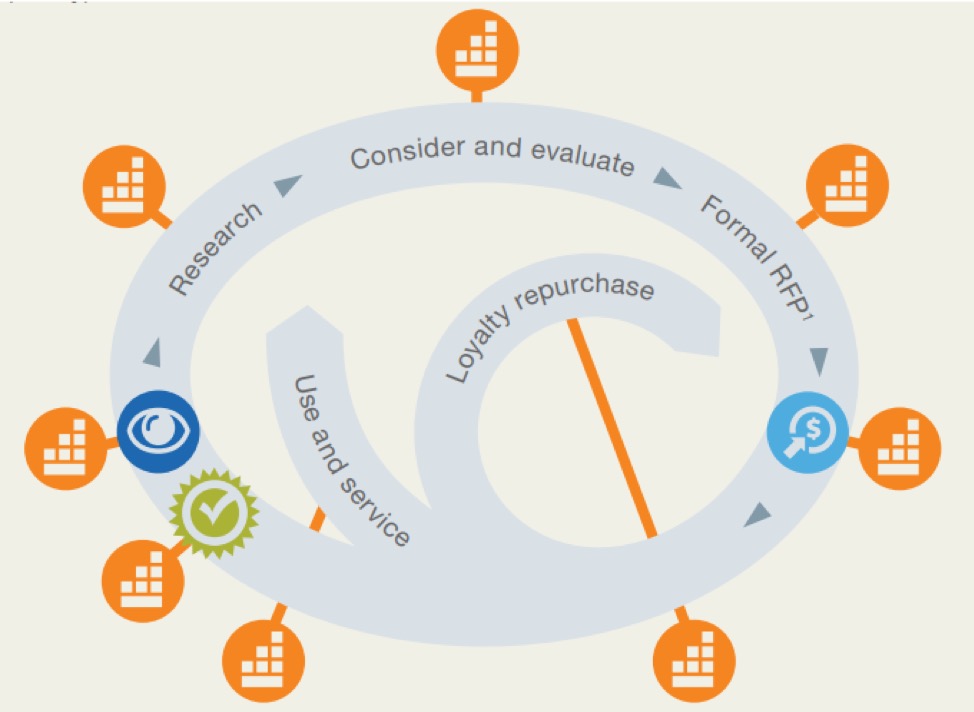

Right here’s a zoomed-in interpretation of the identical from Gartner:
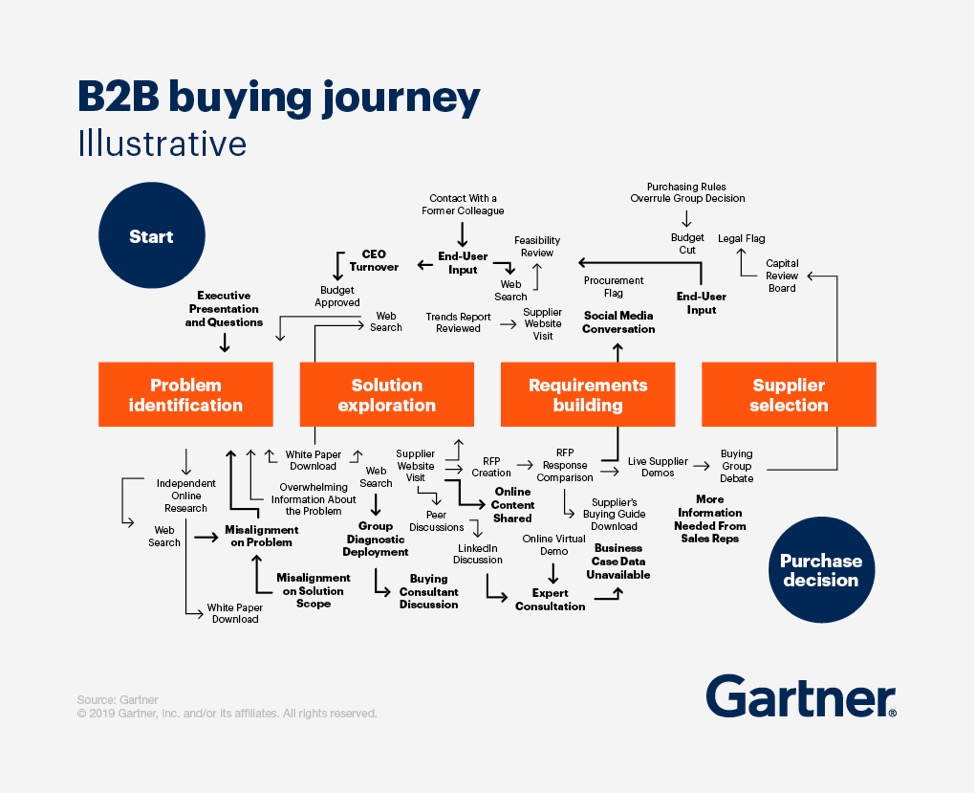

With multi-page personalizations, you may
personalize lots of this journey for every of your high segments.
In distinction, a custom-made touchdown web page will,
on the most, serve solely as one private “contact.” And you may inform
greatest the place it lies in shopping for cycles as advanced as these.
If, in our instance, somebody landed on the web site from a sure promotion (say, concentrating on the fintech area), you can set off multi-page personalizations that solely serve them messaging, communications, and content material that help them of their journey as a fintech supplier, targeted on their wants and desired outcomes.
A robust personalization tactic to make use of at
this degree could possibly be to make use of a prescriptive method. (Prescriptive approaches
imply utilizing messaging that recommends to the patrons what they need to go together with
(and why) and the way to proceed.)
HBR recommends a easy but efficient prescription you can attempt:
One of many issues we’ve realized from working with clients such as you is that buying of us are going to become involved, and doubtless late within the course of. And after they are available late, issues are likely to blow up. So that you’ll wish to convey them in earlier. While you try this, they may have two primary questions: X and Y. Right here’s the way to reply them.
You could possibly repurpose this gross sales script snippet
as a web site personalization in some ways.
For instance, on a case research web page, you can
present your leads a popup saying:
“Hey! Why don’t you share this case research
along with your CFO? We’ve at all times discovered fintech of us to incorporate the CFO too late,
and meaning extra back-and-forth for everybody!”
You get the concept, proper?
Personalization-at-scale: One-to-One
The one-to-one personalization sort helps you to
communicate to every particular person in your web site as should you knew them intimately (whether or not or
not they’re personally identifiable).
Relying on the extent of personalization you’re concentrating on, your knowledge wants might compound exponentially from right here. On the very least, you want to throw in three sorts of knowledge to your personalization combine at this level.
1. Knowledge about your totally different advertising and marketing and gross sales campaigns
So let’s say you’re working an account-based
advertising and marketing marketing campaign to advertise your compliance resolution the place you’re concentrating on
about 500 corporations.
And also you’re seeing a number of touches (web site
visits) from a number of stakeholders of the prospect accounts which might be participating
with you.
To actually ship customized experiences to
the people who find themselves visiting your web site due to this marketing campaign, you want some
strong FIRMOGRAPHIC DATA on them. Knowledge that may, a minimum of, acknowledge the corporate
they’re from. As as soon as you already know which goal account they’re from, you may
fine-tune your messaging to match their wants and wishes.
For instance, with our product, Deploy, you may present an individual from Sony Music a homepage that’s customized for Sony Music, on the fly, in a privacy-friendly manner utilizing no private knowledge.


Likewise, should you attend a convention and share enterprise playing cards or brochures or different advertising and marketing collateral with QR codes, you can use UTM PARAMETERS to point out these guests a completely customized web site expertise.
2. Behavioral knowledge
Lots of instances, a customer’s exercise or
habits in your web site may give cues into their preferences, which may be
used for powering personalizations. For example, if a customer reads a useful resource
on the way to use your product in a sure vertical, it might point out they’re
from that vertical. Which implies recommending them comparable assets might assist
interact them higher. Such a lead (that self-identifies) may also be proven a
trial signup web page custom-made for his or her vertical. This naturally improves the
possibilities of a conversion.
In case you’ve outlined viewers segments in your net analytics resolution — say for returning guests or for customers that visited the trial web page however didn’t enroll — you may personalize for them on the phase degree as nicely.
3. Interplay or buy historical past knowledge
In case you’re a B2B enterprise, you’d already
“know” your present clients and all of the leads in your pipeline (and
the totally different levels they’re at of their shopping for journey with you), and in addition
your churned customers.
Knowledge that you’ve on them — out of your CRM,
electronic mail service supplier, and repair assist desk software program and different sources, for
occasion — can be utilized to supply them
extremely customized product experiences or make related upselling and
cross-selling gives.
For instance, if a lead is of their extra
superior shopping for levels and is viewing a recorded demo, you can arrange
multi-page personalizations from that time onward all through the trial signup
or customized demo signup web page.
If this particular person is identifiable, you can additionally
do personalizations that say “Ted
would love to offer you a private walkthrough” (They know Ted, your
gross sales man, who engages with that concentrate on account.)
And so forth…
Teunissen factors out that with implementing
such one-to-one personalizations, privateness is the #1 problem. He goes on to clarify that in such
personalizations, let’s say should you’re a automotive insurance coverage supplier, you’re going
from making
a automotive insurance coverage provide to making a automotive insurance coverage provide customized
along with your customers’ license plate IDs.
Certain, your customers gave you this knowledge after they
crammed your type. However you’re nonetheless tiptoeing intently alongside your customers’ guarded
digital privateness traces and could possibly be thrown off in the event that they understand you as an
intruder.
An answer he suggests is to know the
preferences of the customers and search consent earlier than hyperpersonalizing their
experiences. Being clear concerning the knowledge being collected and its use helps
too.
One other problem such one-to-one
personalizations pose is on the measurability entrance, as a result of generally you
don’t have massive pattern sizes to run them with — and there’s NO management group.
Which means there’s no foolproof technique to
validate the affect of hyperpersonalizations in your conversions.
A key Teunissen suggests to this problem is amassing qualitative suggestions from the customers being proven hyperpersonalized experiences. Their suggestions will let you know, unmistakably, how your personalizations are impacting them. It’ll let you know should you’re actually connecting with them and galvanizing them to behave or should you’re merely being creepy.
Keep in mind: the concept is to be related
So personalize responsibly.
In case you had been to ship an electronic mail or SMS or push to
your lead in the event that they handed by your swanky workplace (sure, there are methods to do
that!), you’re being downright creepy.
Not simply that, pervasive personalizing of
each single component of your web site will even really feel eerie to your leads — for
occasion, exhibiting them photos of the convention they attended or embedding
their LinkedIn profile or Twitter feed.
No one likes being watched or adopted this
manner.
And as a privacy-friendly enterprise, you don’t
wish to be perceived doing that.
So earlier than you roll out any personalizations, consider and reevaluate them and gauge how they could really feel prefer to the focused customers… as a result of the road between relevance and creepiness is fairly skinny.
Begin Small and Begin Now… Roll Out a Pilot
Now, regardless of the way it appears, you don’t at all times
want tens of personalizations working in your web site.
Simply comply with the income and also you’ll know the way
many customized variations could be sufficient. The remainder of the leads can all go to
your primary, generic web site and trickle by way of your common gross sales funnel.
Additionally, you don’t want tens of instruments to run
personalizations. At the very least, not except you’re an enormous enterprise with advanced
multi-channel, multi-platform, or multi-device personalization wants.
In case you solely must personalize your B2B web site, maybe Deploy is all you want. Deploy can acknowledge your leads by their domains and present related messaging. That too with full privateness compliance.
Initially printed Might 25, 2020 – Up to date November 10, 2022
Cellular studying?
Authors
Editors

Carmen Apostu
In her position as Head of Content material at Convert, Carmen is devoted to delivering top-notch content material that folks can’t assist however learn by way of. Join with Carmen on LinkedIn for any inquiries or requests.


